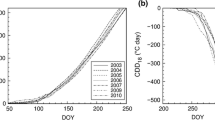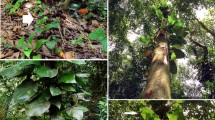Abstract
Early leafing and extended leaf longevity can be important mechanisms for the invasion of the forest understory. We compared the leaf phenology and photosynthetic characteristics of Berberis thunbergii, an early leafing invasive shrub, and two co-occurring native species, evergreen Kalmia latifolia and late leafing Vaccinium corymbosum, throughout the 2004 growing season. Berberis thunbergii leafed out 1 month earlier than V. corymbosum and approximately 2 weeks prior to the overstory trees. The photosynthetic capacity [characterized by the maximum carboxylation rate of Rubisco (V cmax) and the RuBP regeneration capacity mediated by the maximum electron transport rate (J max)] of B. thunbergii was highest in the spring open canopy, and declined with canopy closure. The 2003 overwintering leaves of K. latifolia displayed high V cmax and J max in spring 2004. In new leaves of K. latifolia produced in 2004, the photosynthetic capacity gradually increased to a peak in mid-September, and reduced in late November. V. corymbosum, by contrast, maintained low V cmax and J max throughout the growing season. In B. thunbergii, light acclimation was mediated by adjustment in both leaf mass per unit area and leaf N on a mass basis, but this adjustment was weaker or absent in K. latifolia and V. corymbosum. These results indicated that B. thunbergii utilized high irradiance in the spring while K. latifolia took advantage of high irradiance in the fall and the following spring. By contrast, V. corymbosum generally did not experience a high irradiance environment and was adapted to the low irradiance understory. The apparent success of B. thunbergii therefore, appeared related to a high spring C subsidy and subsequent acclimation to varying irradiance through active N reallocation and leaf morphological modifications.




Similar content being viewed by others
References
Avalos G, Mulkey SS (1999) Photosynthetic acclimation of the liana Stigmaphyllon lindenianum to light changes in a tropical dry forest canopy. Oecologia 120:475–484
Barringer K, Clemants SE (2003) The vascular flora of Black Rock Forest, Cornwall, New York. J Torrey Bot Soc 130:292–308
Bauer H, Thoni W (1988) Photosynthetic light acclimation in fully-developed leaves of the juvenile and adult life phases of Hedera helix. Physiol Plant 73:31–37
Brooks JR, Sprugel DG, Hinckley TM (1996) The effects of light acclimation during and after foliage expansion on photosynthesis of Abies amabilis foliage within the canopy. Oecologia 107:21–32
Cassidy TM, Fownes JH, Harrington RA (2004) Nitrogen limits an invasive perennial shrub in forest understory. Biol Invasions 6:113–121
Chapin FS, Zavaleta ES, Eviner VT, Naylor RL, Vitousek PM, Reynolds HL, Hooper DU, Lavorel S, Sala OE, Hobbie SE, Mack MC, Diaz S (2000) Consequences of changing biodiversity. Nature 405:234–242
Cohen AN, Carlton JT (1998) Accelerating invasion rate in a highly invaded estuary. Science 279:555–558
Daehler CC (2003) Performance comparisons of co-occurring native and alien invasive plants: implications for conservation and restoration. Annu Rev Ecol Evol Syst 34:183–211
Dukes JS, Mooney HA (1999) Does global change increase the success of biological invaders? Trends Ecol Evol 14:135–139
Ehrenfeld JG (1997) Invasion of deciduous forest preserves in the New York metropolitan region by Japanese barberry (Berberis thunbergii DC). J Torrey Bot Soc 124:210–215
Ehrenfeld JG, Kourtev P, Huang WZ (2001) Changes in soil functions following invasions of exotic understory plants in deciduous forests. Ecol Appl 11:1287–1300
Farquhar GD, Sharkey TD (1982) Stomatal conductance and photosynthesis. Annu Rev Plant Physiol Plant Mol Biol 33:317–345
Farquhar GD, Caemmerer SV, Berry JA (1980) A biochemical-model of photosynthetic CO2 assimilation in leaves of C3 species. Planta 149:78–90
Field C, Mooney HA (1986) The photosynthesis nitrogen relationship in wild plants. In: Givnish TJ (ed) On the economy of plant form and function. Cambridge University Press, Cambridge, pp 25–55
Frak E, Le Roux X, Millard P, Dreyer E, Jaouen G, Saint-Joanis B, Wendler R (2001) Changes in total leaf nitrogen and partitioning, of leaf nitrogen drive photosynthetic acclimation to light in fully developed walnut leaves. Plant Cell Environ 24:1279–1288
Funk JL, Vitousek PM (2007) Resource-use efficiency and plant invasion in low-resource systems. Nature 446:1080–1081
Harrington RA, Brown BJ, Reich PB (1989) Ecophysiology of exotic and native shrubs in southern Wisconsin. 1. Relationship of leaf characteristics, resource availability, and phenology to seasonal patterns of carbon gain. Oecologia 80:356–367
Hunter JC, Mattice JA (2002) The spread of woody exotics into the forests of a northeastern landscape, 1938–1999. J Torrey Bot Soc 129:220–227
Hutchinson TF, Vankat JL (1997) Invasibility and effects of Amur honeysuckle in southwestern Ohio forests. Conserv Biol 11:1117–1124
Kamaluddin M, Grace J (1992) Photoinhibition and light acclimation in seedlings of Bischofia javanica, a tropical forest tree from Asia. Ann Bot 69:47–52
Kourtev PS, Ehrenfeld JG, Huang WZ (1998) Effects of exotic plant species on soil properties in hardwood forests of New Jersey. Water Air Soil Pollut 105:493–501
Kourtev PS, Ehrenfeld JG, Haggblom M (2002) Exotic plant species alter the microbial community structure and function in the soil. Ecology 83:3152–3166
Langenheim JH, Osmond CB, Brooks A, Ferrar PJ (1984) Photosynthetic responses to light in seedlings of selected Amazonian and Australian rainforest tree species. Oecologia 63:215–224
Luken JO, Kuddes LM, Tholemeier TC, Haller DM (1997) Comparative responses of Lonicera maackii (Amur honeysuckle) and Lindera benzoin (spicebush) to increased light. Am Midl Nat 138:331–343
Mazia CN, Chaneton EJ, Ghersa CM, Leon RJC (2001) Limits to tree species invasion in pampean grassland and forest plant communities. Oecologia 128:594–602
Meekins JF, McCarthy BC (2001) Effect of environmental variation on the invasive success of a non-indigenous forest herb. Ecol Appl 11:1336–1348
Mooney HA, Hobbs RJ (2000) Invasive species in a changing world. Island Press, Washington, D.C.
Muller O, Hikosaka K, Hirose T (2005) Seasonal changes in light and temperature affect the balance between light harvesting and light utilisation components of photosynthesis in an evergreen understory shrub. Oecologia 143:501–508
Myers CV, Anderson RC (2003) Seasonal variation in photosynthetic rates influences success of an invasive plant, garlic mustard (Alliaria petiolata). Am Midl Nat 150:231–245
Myers CV, Anderson RC, Byers DL (2005) Influence of shading on the growth and leaf photosynthesis of the invasive non-indigenous plant garlic mustard [Alliaria petiolata (M. Bieb) Cavara and Grande] grown under simulated late-winter to mid-spring conditions. J Torrey Bot Soc 132:1–10
Nelson ND, Dickmann DI, Gottschalk KW (1982) Autumnal photosynthesis in short-rotation intensively cultured Populus clones. Photosynthetica 16:321–333
Oguchi R, Hikosaka K, Hirose T (2003) Does the photosynthetic light-acclimation need change in leaf anatomy? Plant Cell Environ 26:505–512
Oguchi R, Hikosaka K, Hirose T (2005) Leaf anatomy as a constraint for photosynthetic acclimation: differential responses in leaf anatomy to increasing growth irradiance among three deciduous trees. Plant Cell Environ 28:916–927
Oren R, Sperry JS, Katul GG, Pataki DE, Ewers BE, Phillips N, Schafer KVR (1999) Survey and synthesis of intra and interspecific variation in stomatal sensitivity to vapour pressure deficit. Plant Cell Environ 22:1515–1526
Otto S, Groffman PM, Findlay SEG, Arreola AE (1999) Invasive plant species and microbial processes in a tidal freshwater marsh. J Environ Qual 28:1252–1257
Popma J, Bongers F (1991) Acclimation of seedlings of 3 Mexican tropical rain-forest tree species to a change in light availability. J Trop Ecol 7:85–97
Reich PB, Ellsworth DS, Walters MB, Vose JM, Gresham C, Volin JC, Bowman WD (1999) Generality of leaf trait relationships: a test across six biomes. Ecology 80:1955–1969
Rothstein DE, Zak DR (2001) Photosynthetic adaptation and acclimation to exploit seasonal periods of direct irradiance in three temperate, deciduous-forest herbs. Funct Ecol 15:722–731
Schierenbeck KA, Marshall JD (1993) Seasonal and diurnal patterns of photosynthetic gas-exchange for Lonicera sempervirens and L. japonica (Caprifoliaceae). Am J Bot 80:1292–1299
Singsaas EL, Ort DR, DeLucia EH (2001) Variation in measured values of photosynthetic quantum yield in ecophysiological studies. Oecologia 128:15–23
Sliander JA, Klepeis DM (1999) The invasion ecology of Japanese barberry (Berberis thunbergii) in the New England landscape. Biol Invasions 1:189–201
Tilman D (1999) The ecological consequences of changes in biodiversity: a search for general principles. Ecology 80:1455–1474
Warren C (2006) Estimating the internal conductance to CO2 movement. Funct Plant Biol 33:431–442
Wright IJ, Groom PK, Lamont BB, Poot P, Prior LD, Reich PB, Schulze ED, Veneklaas EJ, Westoby M (2004) Leaf trait relationships in Australian plant species. Funct Plant Biol 31:551–558
Yoshie F, Yoshida S (1987) Seasonal-changes in photosynthetic characteristics of Anemone raddeana, a spring-active geophyte, in the temperate region of Japan. Oecologia 72:202–206
Zotz G, Franke M, Woitke M (2000) Leaf phenology and seasonal carbon gain in the invasive plant, Bunias orientalis L. Plant Biol 2:653–658
Acknowledgements
We thank the staff of the Black Rock Forest for their assistance throughout these experiments and for access to the field site. This research was supported by the Black Rock Forest Consortium through the Stiefel Foundation Small Grants for Scientific Research. We also thank three reviewers and the subject editor for their constructive comments.
Author information
Authors and Affiliations
Corresponding author
Additional information
Communicated by Robert Pearcy.
Rights and permissions
About this article
Cite this article
Xu, CY., Griffin, K.L. & Schuster, W.S.F. Leaf phenology and seasonal variation of photosynthesis of invasive Berberis thunbergii (Japanese barberry) and two co-occurring native understory shrubs in a northeastern United States deciduous forest. Oecologia 154, 11–21 (2007). https://doi.org/10.1007/s00442-007-0807-y
Received:
Accepted:
Published:
Issue Date:
DOI: https://doi.org/10.1007/s00442-007-0807-y




